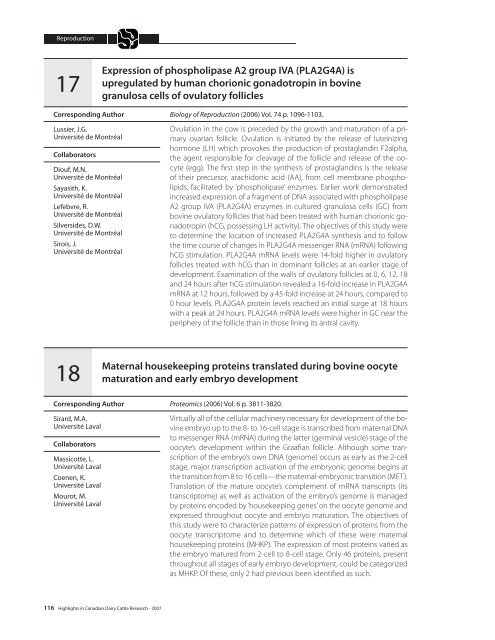A52-75-2007E.pdf - AgroMedia International Inc
A52-75-2007E.pdf - AgroMedia International Inc
A52-75-2007E.pdf - AgroMedia International Inc
You also want an ePaper? Increase the reach of your titles
YUMPU automatically turns print PDFs into web optimized ePapers that Google loves.
Reproduction17Expression of phospholipase A2 group IVA (PLA2G4A) isupregulated by human chorionic gonadotropin in bovinegranulosa cells of ovulatory folliclesCorresponding AuthorLussier, J.G.Université de MontréalCollaboratorsDiouf, M.N.Université de MontréalSayasith, K.Université de MontréalLefebvre, R.Université de MontréalSilversides, D.W.Université de MontréalSirois, J.Université de MontréalBiology of Reproduction (2006) Vol. 74 p. 1096-1103.Ovulation in the cow is preceded by the growth and maturation of a primaryovarian follicle. Ovulation is initiated by the release of luteinizinghormone (LH) which provokes the production of prostaglandin F2alpha,the agent responsible for cleavage of the follicle and release of the oocyte(egg). The first step in the synthesis of prostaglandins is the releaseof their precursor, arachidonic acid (AA), from cell membrane phospholipids,facilitated by ‘phospholipase’ enzymes. Earlier work demonstratedincreased expression of a fragment of DNA associated with phospholipaseA2 group IVA (PLA2G4A) enzymes in cultured granulosa cells (GC) frombovine ovulatory follicles that had been treated with human chorionic gonadotropin(hCG, possessing LH activity). The objectives of this study wereto determine the location of increased PLA2G4A synthesis and to followthe time course of changes in PLA2G4A messenger RNA (mRNA) followinghCG stimulation. PLA2G4A mRNA levels were 14-fold higher in ovulatoryfollicles treated with hCG than in dominant follicles at an earlier stage ofdevelopment. Examination of the walls of ovulatory follicles at 0, 6, 12, 18and 24 hours after hCG stimulation revealed a 16-fold increase in PLA2G4AmRNA at 12 hours, followed by a 45-fold increase at 24 hours, compared to0 hour levels. PLA2G4A protein levels reached an initial surge at 18 hourswith a peak at 24 hours. PLA2G4A mRNA levels were higher in GC near theperiphery of the follicle than in those lining its antral cavity.18Maternal housekeeping proteins translated during bovine oocytematuration and early embryo developmentCorresponding AuthorSirard, M.A.Université LavalCollaboratorsMassicotte, L.Université LavalCoenen, K.Université LavalMourot, M.Université LavalProteomics (2006) Vol. 6 p. 3811-3820.Virtually all of the cellular machinery necessary for development of the bovineembryo up to the 8- to 16-cell stage is transcribed from maternal DNAto messenger RNA (mRNA) during the latter (germinal vesicle) stage of theoocyte’s development within the Graafian follicle. Although some transcriptionof the embryo’s own DNA (genome) occurs as early as the 2-cellstage, major transcription activation of the embryonic genome begins atthe transition from 8 to 16 cells—the maternal-embryonic transition (MET).Translation of the mature oocyte’s complement of mRNA transcripts (itstranscriptome) as well as activation of the embryo’s genome is managedby proteins encoded by ‘housekeeping genes’ on the oocyte genome andexpressed throughout oocyte and embryo maturation. The objectives ofthis study were to characterize patterns of expression of proteins from theoocyte transcriptome and to determine which of these were maternalhousekeeping proteins (MHKP). The expression of most proteins varied asthe embryo matured from 2-cell to 8-cell stage. Only 46 proteins, presentthroughout all stages of early embryo development, could be categorizedas MHKP. Of these, only 2 had previous been identified as such.116 Highlights in Canadian Dairy Cattle Research - 2007





